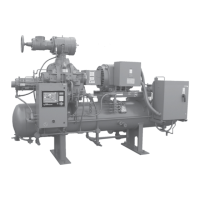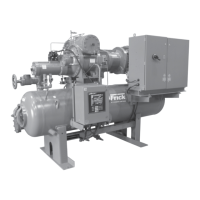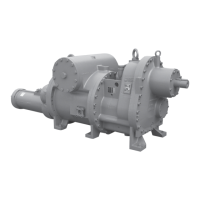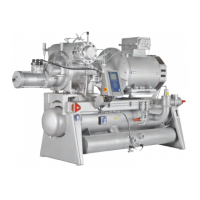RWB II ROTARY SCREW COMPRESSOR UNITS
PROPER INSTALLATION OF ELECTRONIC EQUIPMENT
070.200-IOM (DEC 11)
Page 49
GROUNDING
Grounding is the most important factor for successful opera‑
tion and is typically the most overlooked. The NEC states that
control equipment may be grounded by using the rigid conduit
as a conductor. This worked for the earlier relay systems, but
it is in no way acceptable for electronic control equipment.
Conduit is made of steel and is a poor conductor relative to an
insulated stranded copper wire. Electronic equipment reacts
to very small currents and must have a proper ground in order
to operate properly; therefore, stranded copper grounds are
required for proper operation.
For proper operation, the control power ground circuit must
be a single continuous circuit of the proper sized insulated
stranded conductor, from the electronic control panel to the
plant supply transformer (Figure 41). Driving a ground stake
at the electronic control may also cause additional problems
since other equipment in the plant on the same circuits may
ground themselves to the ground stake causing large ground
flow at the electronic control panel. Also, running multiple
ground conductors into the electronic control panel from
various locations can create multiple potentials resulting in
ground loop currents. A single ground wire (10 AWG or 8
AWG) from the electronic control panel, that is bonded to
the control power neutral at the secondary side of the control
power transformer in the starter and then to the 3‑phase
ground point, will yield the best results.
Figure 41
NOTE: Structural grounding can also result in multiple
ground potentials and is also a relatively poor conductor.
Therefore, this is not an acceptable method for proper
operation of electronic equipment.
There must be a ground for the three‑phase power wiring.
This must be sized in accordance to the NEC and any local
codes relative to the highest rated circuit overload protec‑
tion provided in the circuit. The manufacturer may require a
larger ground conductor than what is required by the NEC
for proper steering of EMI from sensitive circuits. This con‑
ductor must also be insulated to avoid inadvertent contact at
multiple points to ground, which could create Ground Loops.
In many installations that are having electronic control prob‑
lems, this essential wire is usually missing, is not insulated,
or improperly sized.
NEC size ratings are for safety purposes and not necessarily
for adequate relaying of noise (EMI) to earth ground to avoid
possible interference with sensitive equipment. Therefore siz‑
ing this conductor 1 – 2 sizes larger than required by code
will provide better transfer of this noise.
Johnson Controls‑Frick
®
requires that the ground conductor
meet the following:
• Stranded Copper
• Insulated
• One size larger than NEC requirements for conventional
starters
• Two sizes larger than NEC requirements for VFD
starters
• Conduit must be grounded at each end
• This circuit must be complete from the motor to the starter
continuing in a seamless manner back to the plant supply
transformer (power source).
For Direct Coupled, Package Mounted Starters, the ground
between the motor and the starter may need to be made
externally (Figure 42). The connection on the starter end
must be on the starter side of the vibration isolators. Be
certain the connection is metal to metal. Paint may need
to be removed to ensure a proper conductive circuit. The
use of counter‑sunk star washers at the point of connec‑
tion at each end will maximize metal to metal contact.
Figure 42
VFD APPLICATIONS
The primary ground conductor that accompanies the three‑
phase supply must be stranded copper, insulated and two
sizes larger than the minimum required by the NEC or
any other applicable codes. This is necessary due to the
increased generation of EMI which is a characteristic of a
VFD output to the motor when compared to a conventional
starter.
For VFD applications, isolation of the control power, analog
devices, and communications ground from the 3‑phase
ground within the starter and the electronic control panel may
be necessary. This is due to the higher noise (RFI/EMI) levels
generated between the VFD output and the motor, relative
to a conventional starter. If these grounds are left coupled

